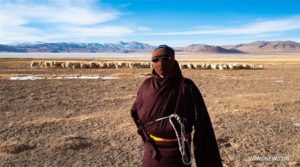
Chinese authorities in Tibet Autonomous Region (TAR) are implementing the so-called Ecological Relocation Plan (2018-2025) for extremely high altitude areas of more than 4,800 meters in Nagchu (Ch: Naqu), Ngari (Ch: Ali), and Shigatse (Ch: Xigaze) cities.
The policy is aimed at relocating more than 130,000 people living in 20 counties, 97 townships, and 450 villages, out of which more than 100,000 people will be relocated along the banks of Yarlung Tsangpo River (upper stream of Brahmaputra), where the government is building a “modern town with complete facilities on an extensive scale”, reported Xinhua on 18 March.
The report quoted Tashi Dorjee, director of the Nature Reserve Management Division of the TAR Forestry and Grassland Bureau, as saying that the purpose of the relocation was “to allow people from extremely high altitude areas to enjoy a better level of life with health protection and public services, while reducing human activities to protect the environment and return nature to wild animals.”
Dorjee blamed global warming and increasing population for exacerbating the “contradiction between domestic animals and wild animals competing for grassland resources” creating problems for the ecological protection of natural reserves. He further claimed that grasslands were deteriorating at an annual rate of 3 to 5 per cent in nine of the nature reserves in the high altitude areas including Tsonyi (Ch: Shuanghu) County in Nagchu.
Tsonyi is one of the seven counties that come under the Qiangtang National Nature Reserve located in Nagchu and Ngari spanning 298,000 square kilometers, which accounts for 25% of the TAR’s total land area. While the counties of Amdo, Nyima, and Tsonyi are located in Nagchu, Gertse, Gegye, Rutok and Gar are in Ngari. Tsonyi lies in the middle of the nature reserve with 135 staff members employed in the county’s 15 wildlife management and conservation stations.
The relocation project will result in making nearly 350,000 square kilometers of land unavailable for human activities, a substantial number considering that the combined land size of Ngari, Nagchu, and Shigatse is more than 800,000 sq. km. More than 80 per cent of the targeted area under the plan consists of protected areas from where all grazing is banned and nomadic livelihood is criminalised. The Chinese authorities claimed that the relocation plan would improve the ecological environment by increasing grassland coverage by an average of 10 to 20 per cent.
By the end of last year, 2900 people from Tsonyi County had been relocated nearly 1,000 km towards the south to a newly-built resettlement village named Sumpori Village, Gongkar (Ch: Gongga) County, Lhokha (Ch: Shannan) City. Located on the north bank of the Yarlung Tsangpo, Sumpori is over 10 km from Lhasa Gongkar Airport and over 60 kilometers from Lhasa city.
In January 2019, Zhang Jianhua, the Party secretary of Tsonyi had announced the relocation of about 3,900 residents from the county’s three townships, insisting that the “relocation policy is not coercive, it’s optional”
Chinese authorities continue to project the relocation policy as a means to combat climate change, “solve the contradiction between man and nature, and to make room for wild animals”. This despite the fact that a growing number of Chinese and foreign grassland experts have cautioned against settling nomads citing the necessity of livestock mobility to ensure the health of the grasslands and mitigate negative impacts of global warming.
By displacing and dispossessing Tibetan nomads, Chinese authorities have advanced a deceptive narrative that frames the relocation/resettlement policy as an environmental protection project, rather than a full-scale land grab to control the headwaters of six of the largest rivers of Asia.
China’s nomad relocation policy values grass and water as more important than livestock and pastoral livelihoods. This proposition ignores global pastoral practices of maintaining a balance between grazing animals and grass, a balance usually maintained productively and sustainably through the strategy of mobility.
In a critical indictment of the devastating impacts of the relocation policy, development specialist Gabriel Lafitte wrote: “On a map, this looks like an impressive commitment to grow more grass and sequester more carbon, offsetting all those coal fired emissions. On the ground, for hundreds of thousands of pastoral nomads, it means total loss of livelihood, herded off their land into concrete barracks often far from their lands, their herds compulsorily sold, with no training to enter the modern cash economy of wage labour.”
